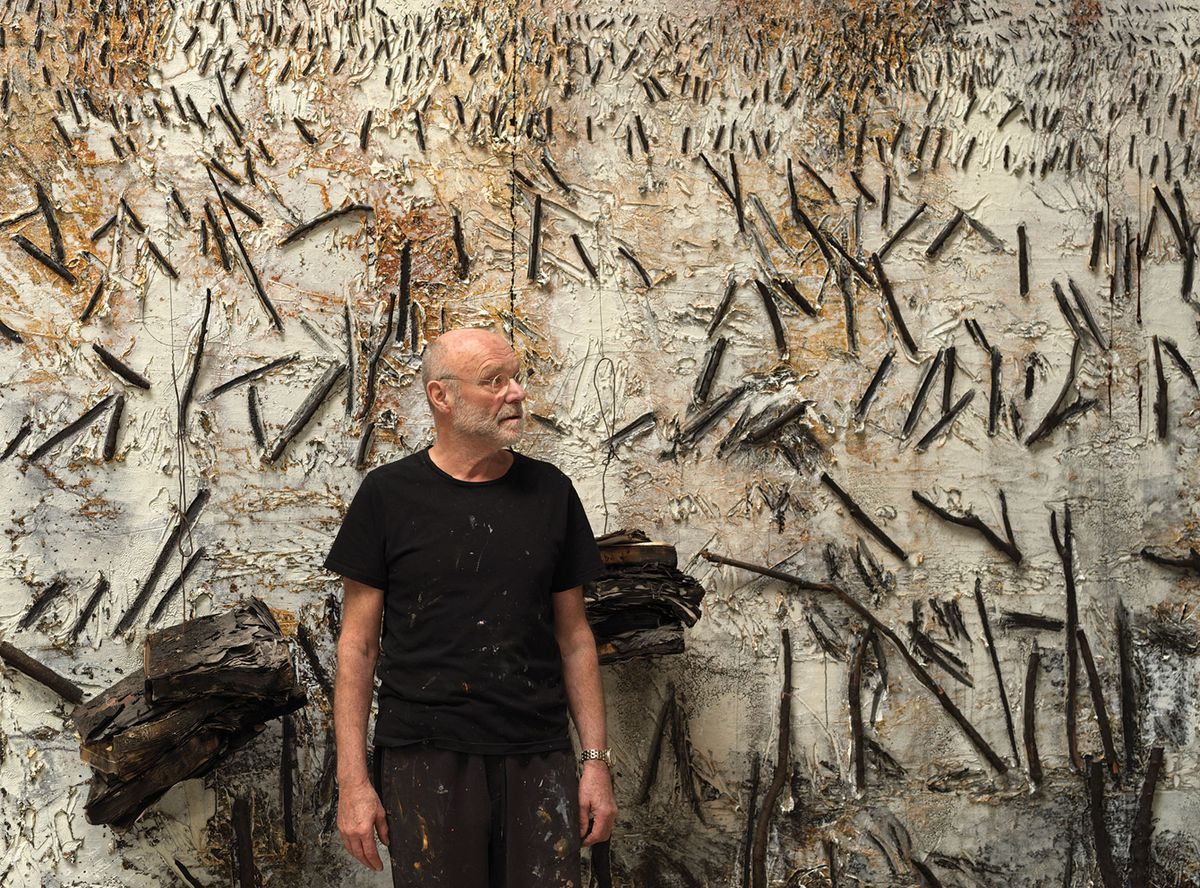In 1577 a devastating fire in the Palazzo Ducale, home to Venice’s ruling doges, destroyed the Sala dello Scrutinio, a grand chamber used for civic elections. The room was rebuilt over the following decades, with some of the Venetian Republic’s greatest artists, including Tintoretto and Jacopo Palma the Younger, creating massive paintings to celebrate the occasion. Now, for the first time, a single artist, Anselm Kiefer, has taken over the immense space and covers up those Venetian works with his own towering take on Venice, consisting of 14 paintings that incorporate zinc, lead, real gold, real clothes—and parts of shopping trolleys.
Anselm Kiefer: Questi scritti, quando verranno bruciati, daranno finalmente un po’ di luce (these writings, when burned, will finally give some light) is set to be a leading side exhibition during the Biennale. Kiefer’s usurping of works such as Tintoretto’s Conquest of Zara (1584), depicting an event from the Fourth Crusade, represents a “layer of contemporary history over the ancient”, says Gabriella Belli, the director of the Fondazione Musei Civici di Venezia, who is co-curating the show with Finland’s Janne Sirén. The cycle continues with an additional seven-part painting in an apse in an adjacent room.
Kiefer’s work represents ‘a layer of contemporary history over the ancient’Gabriella Belli, co-curator
The show’s title comes from an obscure 20th-century Venetian philosopher, Andrea Emo, says Belli, “to whose thought Kiefer feels very close”. It suggests that “producing and destroying are one”, she says, and the new Kiefer works use Venetian motifs to comment on the artist’s perennial themes of creation, destruction and transformation. Completed during the pandemic, the works have a very precise but non-narrative order, stresses Belli.
On the chamber’s north wall, an anchor work measuring 840cm x 760cm “shows a frozen lagoon landscape”, says Sirén, the director of the Albright-Knox Art Gallery in Buffalo, New York. Below the horizon lies a small crusader castle, while the work’s “almost Turner-like” exploding sky contains golden cupola-like structures that may suggest the domes of St Mark’s Basilica, he says, or perhaps the Venetian doges’ distinctive hat.
On the east wall, an even larger, more calamitous work, this time more than 15 metres long, shows the arcades of Piazza San Marco overtaken by fire, “or some other unspecified force”, says Sirén, and suggests “the solid melting into something vaporous”. Opposite, on the west wall, stands a work that incorporates the empty casket of St Mark, Venice’s patron saint, forged out of zinc and presiding over a barren landscape.
Ashen palette
The near-ashen interpretation of Venetian history belies the rather jolly disposition of its creator, the German-born, French-based artist, who, at 77, still seems in his prime.
“I like jokes,” says Kiefer, speaking from his studio outside Paris. He is alluding to the cycle’s ghostly submarine motif, meant to evoke Venice’s former maritime might, but he could also be referring more generally to a creative process that can sound like a prank. Noted for a palette that can typically run from brown to black, Kiefer’s paintings actually start out full of colour—“like Impressionism”, he insists—which then fade, under ever more paint layers, into what can seem like dirt in the moonlight.
Like many creative personalities, he has found the peace and quiet of the pandemic conducive to working. “It’s been fantastic,” he says. “No more visitors, no more phone calls.” With much of the world on hold, he found inspiration in an old German paperback edition of the second part of Goethe’s play Faust, in which a synthesis of classical antiquity and German Romanticism pointed a way for him to regard Venice as “a junction between the Occident and the Orient”.
The airy realm of literary allusion was accompanied by the hands-on activity of making art, including deciding what to do with those bits of shopping trolleys, which he has placed on canvas in a peculiar procession, accompanied by the names of the doges. Kiefer eventually accentuated them with straw. “I made them a little more beautiful,” he says.
• Anselm Kiefer: Questi scritti, quando verranno bruciati, daranno finalmente un po’ di luce (Andrea Emo), Palazzo Ducale, until 29 October


